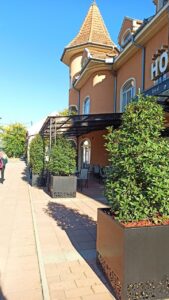How do local markets and shops influence the real estate market in Subotica?
Subotica, a vibrant city located in northern Serbia, is known for its rich cultural heritage and diverse community. As the city continues to grow, the interplay between local markets, shops, and the real estate market becomes increasingly significant. Understanding how these local businesses influence property values and neighborhood dynamics can provide valuable insights for potential investors, homeowners, and urban planners alike. This article delves into the multifaceted relationship between local markets and shops and the real estate market in Subotica.
The Role of Local Markets in Shaping Neighborhood Appeal
Local markets in Subotica serve as vital hubs of community interaction and commerce. They not only provide residents with access to fresh produce and artisanal goods but also foster a sense of belonging and local identity. The presence of these markets can significantly enhance the appeal of neighborhoods, making them more attractive to potential homebuyers. Areas with vibrant local markets often see an uptick in demand for housing, as buyers are drawn to the convenience and lifestyle that these markets offer.
Moreover, local markets contribute to the overall aesthetic and cultural fabric of a neighborhood. They often host events, festivals, and seasonal activities that engage the community and draw visitors from surrounding areas. This increased foot traffic can lead to higher property values, as homes in proximity to these lively centers are perceived as more desirable. Consequently, neighborhoods with thriving local markets tend to experience a positive feedback loop, where increased demand for housing further supports the growth and sustainability of these markets.
Additionally, the economic impact of local markets cannot be overlooked. They create jobs and stimulate local businesses, which in turn contributes to the overall economic health of Subotica. As local markets thrive, they attract more residents and businesses, leading to increased investment in the area. This economic vitality is a key factor that influences real estate prices, as investors and homebuyers recognize the potential for growth and development in neighborhoods with strong local market presence.
The Influence of Shops on Property Values
Shops, particularly those that cater to everyday needs, play a crucial role in determining property values in Subotica. The availability of grocery stores, pharmacies, and other essential services can significantly impact a neighborhood’s desirability. Homebuyers often prioritize access to these amenities when searching for properties, leading to increased demand in areas with a robust retail presence. Consequently, neighborhoods with a diverse range of shops tend to see higher property values compared to those lacking such amenities.
Furthermore, the quality and variety of shops can also influence the demographic profile of a neighborhood. Areas with upscale boutiques, specialty stores, and trendy cafes may attract a younger, more affluent population, which can drive up property prices. Conversely, neighborhoods with limited shopping options may struggle to attract buyers, leading to stagnation or decline in property values. This dynamic underscores the importance of a well-rounded retail landscape in shaping the real estate market in Subotica.
In addition to influencing property values, shops also contribute to the overall livability of a neighborhood. A vibrant retail scene enhances the quality of life for residents, providing them with convenient access to goods and services. This, in turn, can lead to increased demand for housing in those areas, further driving up property values. As such, the presence of diverse and high-quality shops is a critical factor in the real estate market dynamics of Subotica.
The Interconnectedness of Local Markets, Shops, and Real Estate Trends
The relationship between local markets, shops, and the real estate market in Subotica is inherently interconnected. As local markets thrive and attract more visitors, they create a ripple effect that benefits nearby shops and, ultimately, the real estate market. Increased foot traffic and consumer spending can lead to the establishment of new businesses, further enhancing the appeal of the neighborhood. This symbiotic relationship fosters a vibrant community atmosphere that is attractive to potential homebuyers.
Moreover, the growth of local markets and shops can influence urban planning and development initiatives in Subotica. City planners and policymakers often recognize the importance of these local businesses in driving economic growth and community engagement. As a result, they may prioritize investments in infrastructure and public spaces that support the continued success of local markets and shops. This, in turn, can lead to increased property values and a more dynamic real estate market.
Finally, the evolving landscape of local markets and shops in Subotica reflects broader trends in consumer behavior and urban living. As residents increasingly seek convenience and community-oriented experiences, the demand for neighborhoods with strong local market presence will likely continue to rise. This shift will have lasting implications for the real estate market, as buyers prioritize areas that offer not only housing but also a vibrant lifestyle supported by local commerce.
In conclusion, local markets and shops play a pivotal role in shaping the real estate market in Subotica. Their influence extends beyond mere convenience, impacting property values, neighborhood appeal, and overall community dynamics. As the city continues to evolve, understanding the interconnectedness of these local businesses and the real estate market will be essential for stakeholders looking to navigate the complexities of urban development in Subotica. By fostering a thriving local commerce environment, the city can enhance its attractiveness to residents and investors alike, ensuring sustainable growth for years to come.



